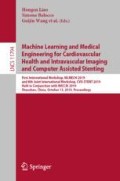Abstract
Cardiovascular disease (CVD) is one of the most serious diseases that harm human life and gives a huge burden to the health care system. Recent advances in deep learning have achieved great success in object detection, speech and image recognition. Although deep learning has been applied to the detection of arrhythmia, detection accuracy is limited because of three major issues: 1. Each ECG signal maybe contains more than one-label information; 2. It is hard to classify ECG with different lengths; 3. Data imbalance problem is severe for arrhythmia detection. In this paper, we present a multi-label learning algorithm to address the class imbalance and detection on ECGs with different durations. We utilize Deep Convolutional Generative Adversarial Networks (DCGANs) and Wasserstein GAN-Gradient Penalty (WGAN-GP) to generate new positive samples and use two losses to balance the importance between positive samples and negative samples. Moreover, we construct a Squeeze and Excitation-ResNet (SE-ResNet) module for normal rhythm and arrhythmia detection. In order to solve the multi-label classification problem, we train nine different binary classifiers for each category and determine which types of rhythm the ECG signals belong to. Experimental results on The ECG Intelligence Challenge 2019 dataset demonstrate that our multi-label learning method achieves competitive performance in multi-label ECGs classification.
Access this chapter
Tax calculation will be finalised at checkout
Purchases are for personal use only
References
Thomas, H., Diamond, J., Vieco, A., et al.: Global atlas of cardiovascular disease 2000–2016: the path to prevention and control. Glob. Heart 13(3), 143 (2018)
Mehra, R.: Global public health problem of sudden cardiac death. J. Electrocardiol. 40(6-supp-S1), S118–S122 (2007)
Ye, C., Kumar, B.V.K.V., Coimbra, M.T.: Combining general multi-class and specific two-class classifiers for improved customized ECG heartbeat classification. In: 2012 21st International Conference on Pattern Recognition (ICPR 2012). IEEE Computer Society (2012)
Mar, T., Zaunseder, S., Martínez, J.P., Llamedo, M., Poll, R.: Optimization of ECG classification by means of feature selection. IEEE Trans. Bio-Med. Eng. 58(8), 2168–2177 (2011)
Chazal, P.D., O’Dwyer, M., Reilly, R.B.: Automatic classification of heartbeats using ECG morphology and heartbeat interval features. IEEE Trans. Biomed. Eng. 51(7), 1196–1206 (2004)
Moran, M.E., Soriano, M.C., Fischer, I., et al.: Electrocardiogram classification using reservoir computing with logistic regression. IEEE J. Biomed. Health Inform. 19(3) (2014)
Hong, S., Wu, M., et al.: ENCASE: an ensemble classifier for ECG classification using expert features and deep neural networks (2017)
Hannun, A.Y., Rajpurkar, P., Haghpanahi, M., et al.: Cardiologist-level arrhythmia detection and classification in ambulatory electrocardiograms using a deep neural network. Nat. Med. 25, 65–69 (2019)
Zhang, Q., Zhou, D.: Deep Arm/Ear-ECG image learning for highly wearable biometric human identification. Ann. Biomed. Eng. 46(1), 1–13 (2017)
Zhang, M.-L., Zhou, Z.-H.: A review on multi-label learning algorithms. IEEE Trans. Knowl. Data Eng. 26(8), 1819–1837 (2014)
Poungponsri, S., Yu, X.H.: An adaptive filtering approach for electrocardiogram (ECG) signal noise reduction using neural networks. Neurocomputing 117, 206–213 (2013)
Goodfellow, I.J., et al.: Generative adversarial nets. In: NIPS (2014)
Radford, A., Metz, L., Chintala, S.: Unsupervised representation learning with deep convolutional generative adversarial networks. arXiv preprint arXiv:1511.06434 (2015)
Gulrajani, I., Ahmed, F., Arjovsky, M., Dumoulin, V., Courville, A.C.: Improved training of wasserstein GANs. CoRR, abs/1704.00028 (2017)
Lin, T., Goyal, P., Girshick, R.B., He, K., Dollar, P.: Focal loss for dense object detection. In: IEEE ICCV (2017)
Li, B., Liu, Y., Wang, X.: Gradient harmonized single stage detector. In: AAAI Conference on Artificial Intelligence (2019)
He, K., Zhang, X., Ren, S., Sun, J.: Deep residual learning for image recognition. In: CVPR (2016)
Hu, J., Shen, L., Sun, G.: Squeeze-and-excitation networks. In: CVPR (2018)
Kingma, D.P., Ba, J.L.: Adam: a method for stochastic optimization. In: Proceedings of International Conference on Learning Representations, pp. 1–15 (2015)
Acknowledgements
This work was supported by the National Natural Science Foundation of China (No.61571628).
Author information
Authors and Affiliations
Corresponding author
Editor information
Editors and Affiliations
Rights and permissions
Copyright information
© 2019 Springer Nature Switzerland AG
About this paper
Cite this paper
Zhu, J., Xin, K., Zhao, Q., Zhang, Y. (2019). A Multi-label Learning Method to Detect Arrhythmia Based on 12-Lead ECGs. In: Liao, H., et al. Machine Learning and Medical Engineering for Cardiovascular Health and Intravascular Imaging and Computer Assisted Stenting. MLMECH CVII-STENT 2019 2019. Lecture Notes in Computer Science(), vol 11794. Springer, Cham. https://doi.org/10.1007/978-3-030-33327-0_2
Download citation
DOI: https://doi.org/10.1007/978-3-030-33327-0_2
Published:
Publisher Name: Springer, Cham
Print ISBN: 978-3-030-33326-3
Online ISBN: 978-3-030-33327-0
eBook Packages: Computer ScienceComputer Science (R0)


